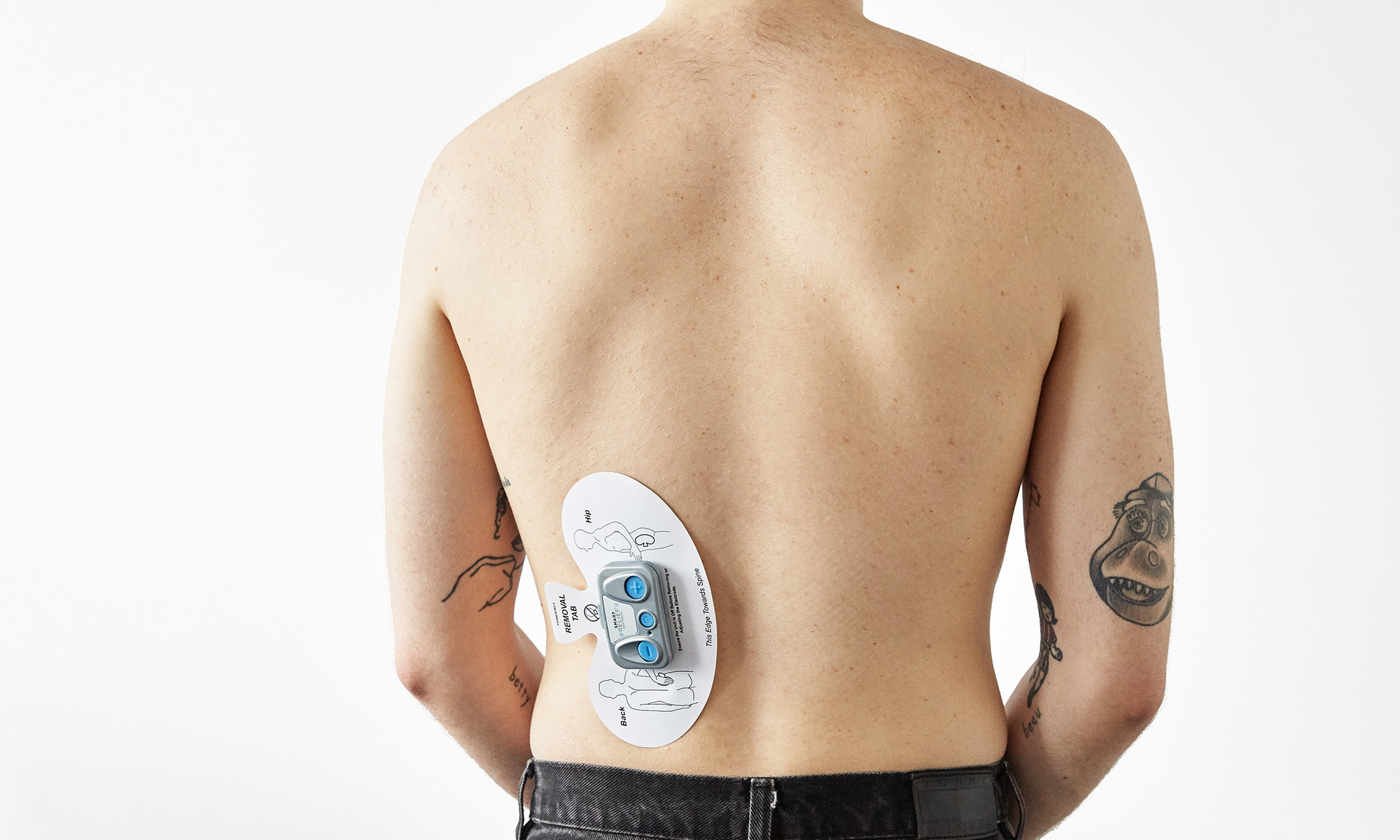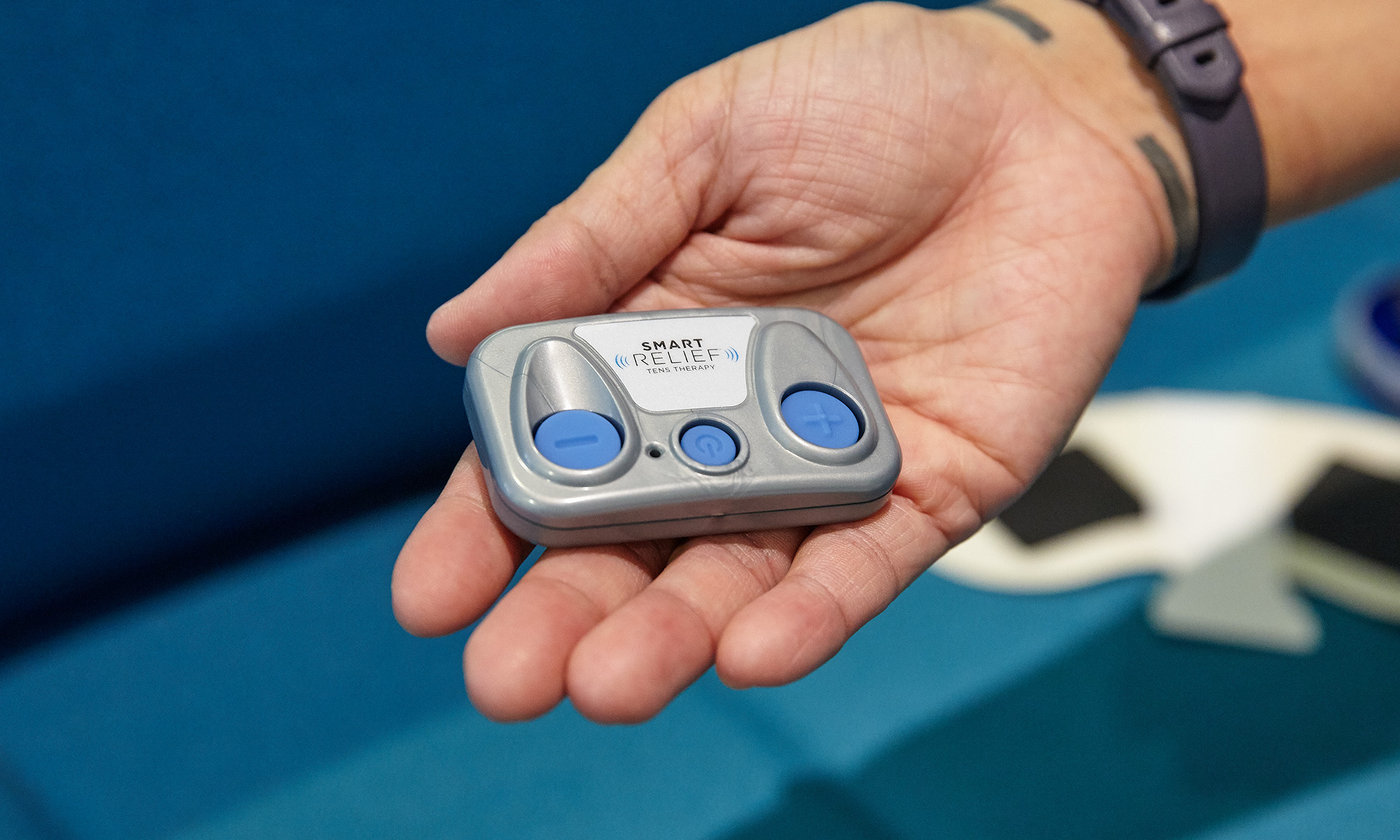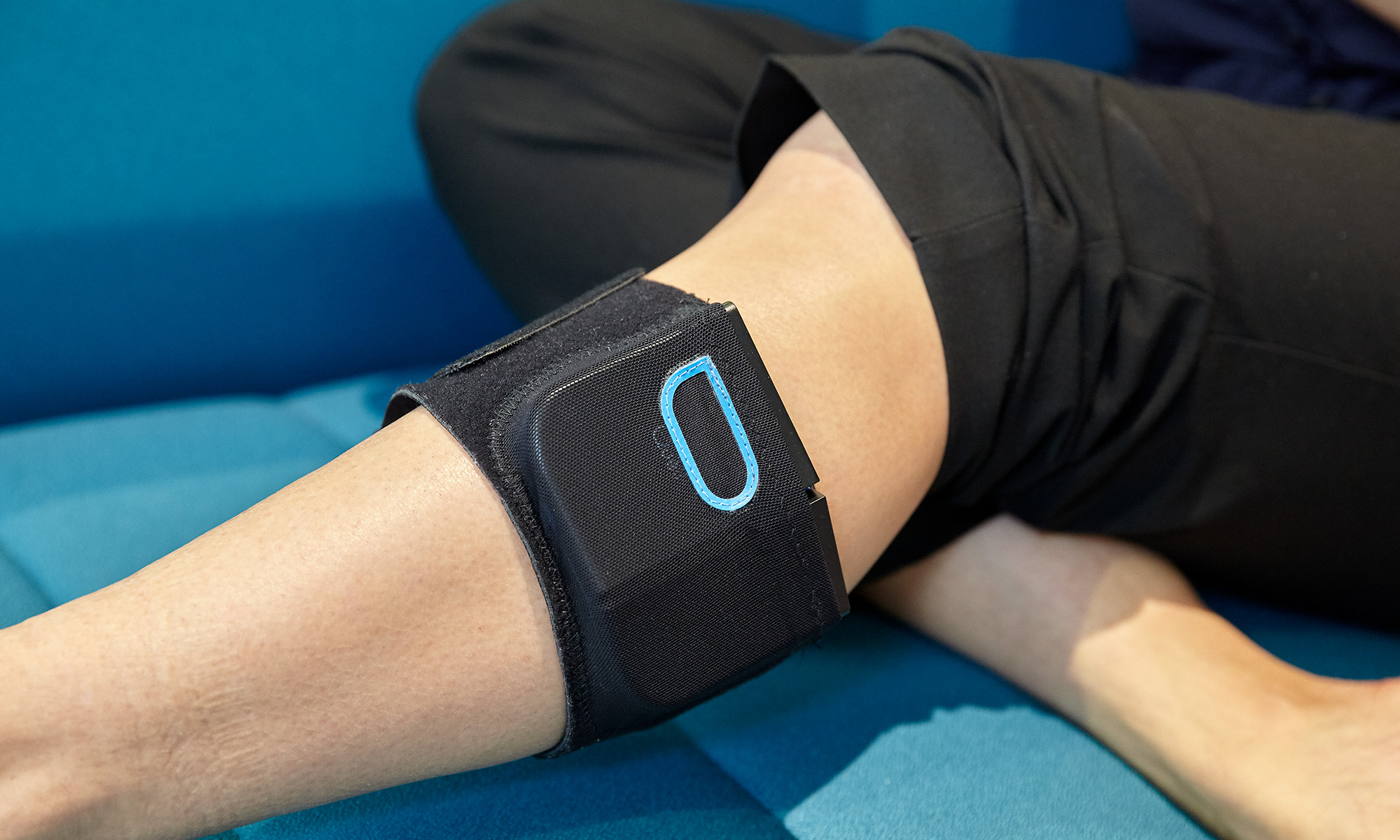Pain Relief Tech Sounds Great, But Does It Really Work?
I tried four pain relief devices, including TENS (electricity), PEMF (magnets) and light therapy options. Here's what I found with each.
As anyone who suffers from chronic pain knows, finding a "cure" or even just a bit of relief can feel like an endless challenge. Sometimes, medications, physical therapy and even surgery aren't a cure, but some tech companies have developed consumer-friendly devices that they say can help.

So how well do these devices really work? I have been dealing with chronic pain on the left side of my upper back for several months, so I tried several pain-relief devices to see if they would help.
TENS Devices: Zapping the pain away
Transcutaneous Electrical Nerve Stimulation (TENS) devices are the most common pain relief gadgets out there. They attach to your skin with sticky electrodes, and send a low level of electricity through the skin, ideally to where you're feeling pain. Some doctors say that TENS devices can actually help patients reduce the amount of pain-relieving medications they need to use, including opioids.
Consumer TENS devices that you can buy without a prescription are often marketed as "drug-free pain relief," but how much relief you really feel may vary. For some people, these devices may feel as effective as the TENS treatment you'd get at a chiropractor's office. For other people, however, TENS devices may be too weak, as they don't all deliver as much electricity as you'd get with a professional or prescription TENS device. Also, since a TENS device can interfere with implanted electrical devices, don't use a TENS device if you have a pacemaker.
Whether a TENS device is effective depends on the individual and his or her specific type of pain.
"The issue with gadgets is, in the vast majority of cases, the pain isn't really where the problem is," says Dr. Binyamin Rothstein, an osteopathic doctor who focuses his practice on pain relief, ideally without the use of prescription drugs.
Icy Hot SmartRelief
Designed specifically for the back, hip, knee and shoulder, the SmartRelief costs $29.99, which includes one reusable electrode pad. A electrode refill pack, including a replacement coin cell battery, costs an additional $14.99, and should last about a month.

The SmartRelief device itself is a 2.5 x 1.5 x 0.5-inch gadget that snaps onto a large disposable electrode pad with a sticky side that adheres to your body. It has no remote control that tells you it's on, so you may want to look in the mirror or ask someone to check whether the green LED on the device is blinking.
When I attempted to put the SmartRelief on, I struggled to stick the device to my back by myself. I couldn't see what I was doing, nor did I notice when the electrode pad folded over on itself. Plus, Icy Hot recommends against turning the device on before you place it on your back, so without a mirror or another person present, it was hard at first to tell whether the device was on.
When it was finally on, I was a bit surprised that it made my muscles twitch as if I were vigorously shrugging my shoulder. It also sent a tingling sensation down my arm. It felt a bit like pins and needles, but more uncomfortable and achy.
You can choose from among 63 different intensity levels, which you can adjust with plus and minus buttons on the device. But even with a lower dose, I couldn't handle the added pain and discomfort for more than 5 minutes, so I only used the device twice, for just a few minutes each time.
While I didn't find SmartRelief effective, some users have benefited from it, according to reviews on Amazon.com.
What Owners Are Saying Icy Hot Relief: The Good
Positive reviews on Amazon.com, made by people who actually purchased the device, say it worked well for them, taking them from being doubled over in pain to being able to perform daily tasks, often completely pain-free. "This product is fantastic," one reviewer writes. "It was able to stop some back and hip pain that no amount of over-the-counter medicine could take away. This feels just a strong as the TENS machine my chiropractor uses."
What Owners Are Saying Icy Hot Relief: The Bad
Others say the device didn't help at all. "Incredibly difficult to apply and adjust by myself at work. All settings feel exactly the same: nothing. I can't feel anything," one reviewer says. "The only evidence of it being on is the green light. Otherwise, it is an expensive decoration."
The Quell: More powerful, but pricey
I also tried the Quell, another TENS device. At $249, plus $29.99 per month for additional electrodes, this device is significantly more expensive than the Icy Hot SmartRelief device. NeuroMetrix, the company that makes Quell, says this device is five times as powerful as cheaper TENS devices out there.

The device, which you can recharge using a regular micro USB charger, slips into a cuff, and it's snapped onto the electrodes that stick to your skin. Instead of placing it right over the painful area, you strap the device around your leg, just below your knee, and the electricity should reach wherever it is you feel pain.
It was much easier to put the Quell around my leg than it was to apply the Icy Hot electrodes to my back. Once the Quell is in place, you'll use the Quell app for Android or iOS to calibrate the device, which basically means that you tap on your screen until you feel a change in sensation under and around the Quell.
When I turned the Quell on, I immediately felt tingling radiating from where the device was wrapped around my leg, down to my toes and up to my back, shoulder and arm. While this felt a bit strange and made me a little anxious at first, within minutes, the Quell noticeably alleviated my pain without causing discomfort, unlike the Icy Hot SmartRelief device. I felt better within minutes of putting the Quell on, and I kept it on for about half an hour with no problem.

Once I removed the device, though, the pain came back; I didn't notice any long-term effects from using the Quell. As usual, some days weren't so bad, but on other days, the pain still radiated down my arm enough that I didn't want to move my arm at all.
After I used the Quell about five times, for about 30 minutes each session, sporadically over the course of a few weeks, the battery level fell to about 50 percent. But how long a charge can last varies depending on how the user calibrates the device. Thankfully, since the Quell is rechargeable, there's no need to constantly buy batteries.
NeuroMetrix suggests that users wear the device for at least 4 hours a day. Yet wearing a TENS device for a prolonged period could make the device less effective over time, says Dr. Kiran Patel, director of neurosurgical pain at Lenox Hill Hospital in New York.

NeuroMetrix says it hasn't seen anyone develop a tolerance to the treatment, but if that does happen, users can use the Quell app to recalibrate the device and increase its intensity. The company also says that some users might not get the most benefit from the device until they've used it for a few weeks.
Nothing is a cure-all, and TENS devices do not work to treat diabetic pain, says Dr. Todd Sinett, a chiropractor and applied kinesiologist at Midtown Integrative Health & Wellness in Manhattan.
What Owners Are Saying About the Quell: The Good
Amazon reviews show mixed sentiments.The Quell effectively eliminated serious, chronic pain for many users who'd tried other pain relief methods to no avail. "I've had chronic pain for three years due to sciatica, and I've tried everything to help relieve the pain," says one Amazon reviewer. "I've only had this product for five days, and I've already noticed a drastic reduction in my pain level. The pain is not completely gone, but it's reduced enough where I can finally get a good night's sleep."
What Owners Are Saying About the Quell: The Bad
One of the biggest complaints about the Quell is in reference to the quality of the materials. In my experience, the cuff was noticeably less elastic after just a few uses, and several reviewers who gave the Quell 2 stars or less say the same.
"The Velcro and elastic support band stretches out after one week of use. An expensive product to begin to wear out and stretch," one reviewer writes. "I returned it because I felt it wouldn't last months. I can't say for sure if there was a true pain relief benefit."
PEMF Devices: Strategically placed magnets
Pulsed electromagnetic field (PEMF) therapy devices work with the naturally occurring magnetic fields in the body. The goal is to rev up the electricity within muscle and bone cells, promote blood flow, ease swelling and promote the healing process. While the technology has existed for some time — NASA has a patent on a PEMF device meant to heal wounds — this is not a commonly used pain relieving device, says Dr. Patel.
PEMF devices have been used to help heal muscles and bones, but it's not exactly clear how they interact with the body.
"Although studies on PEMF have been ongoing for more than 20 years, little is known about the molecular and cellular mechanisms involved in their beneficial therapeutic effects," according to one paper published by NASA.
Oska Pulse
The Oska Pulse ($399) is one of a very few PEMF devices that's available for home use without a prescription in the United States. The FDA cleared the company to market the device as a way to reduce inflammation and pain and improve range of motion.

Since PEMF devices work with magnetic fields, they don't need to make direct contact with your skin. You wear the Oska Pulse by inserting the blue, oval-shaped device into an included strap that you can Velcro around your body, so that the Pulse is placed right over the area where you're experiencing pain.
After a few minutes of using the Oska Pulse, my shoulder felt heavy, and not any better. I felt uncomfortable enough to want to take the device off.
I put the Pulse over my shoulder, with the Velcro going across my body, but I couldn't manage to keep it secure enough with the included strap. It would have been better if I'd used an Ace bandage wrapped around my body a few times to make it more secure.
Unlike TENS devices that can make you twitch, you might not feel a thing right away when you're using a PEMF device. But, after a few minutes of use, my shoulder felt heavy, and not any better. I felt uncomfortable enough to want to take it off.
In small trials that Oska itself conducted, some Pulse users felt pain relief right away and swelling subsided quickly. But you may need to use one of the devices for several weeks to get a significant benefit, Oska says. In the handful of times that I wore the Pulse, I didn't feel any improvement in my back pain.
The Oska Pulse is for sale by the manufacturer, but not on Amazon, so there were no reviews on the site from those who've bought the device.
Light Therapy: The power of LEDs
Shining infrared light through your skin could reduce swelling and improve circulation, treating conditions like muscle pain, chronic low-back pain and inflammation from arthritis.
The idea is that infrared light treatments have longer-term benefits, since they help release nitric oxide, therefore speeding up the natural healing process, says pain relief device maker BioCare Systems.
As with TENS devices, infrared devices might provide pain relief to some users within minutes, but it could take weeks of this treatment to really work for other people. And as I experienced, if your pain tends to get worse when you use a heating pad, it could get worse with an infrared device, too, since these tools give off both light and heat.
LumiWave
BioCare makes the LumiWave, which comes as a $499 gadget that's equipped with 200 small infrared LEDs or $720 gadget with 400 LEDs. There are several infrared devices for pain relief that sell for less. But BioCare says its device is more effective than the competitors and worth the cost, because it has more LEDs than, say, the $199 DPL FlexPad Pain Relief System, which has 60 LEDs.
The most inconvenient part of using the LumiWave is that, since it needs to be plugged in while in use, you'll either need to sit next to a power outlet or use an extension cord. Like many TENS devices, it needs to be placed directly on top of the area where you're experiencing pain, and it has to be kept there for 20 to 30 minutes.
Months before I tested any of these pain relief devices, I had used a simple heating pad on my back, but that caused some swelling and increased the pain between my shoulder blades and sometimes down my arm, so I stopped using those pads.

Similarly, the LumiWave warms up to about 105 degrees Fahrenheit, and it started to hurt within minutes of me using it. When I informed a LumiWave representative of my experience, he recommended that I use the device for 20 minutes a day on each side of my spine for a few days and see what happened. I tried the device once more, bust after a few minutes, I again felt discomfort, so I decided to go against LumiWave's recommendations, and stopped using the device.
There was only a single review of the LumiWave posted on Amazon, but it wasn't clear whether it was written by someone who actually purchased the device.
So are pain relief gadgets worth it?
Of the devices I tested, the Quell was most effective, but your experience can depend on your body's response to pain and pain treatments, which can vary from person to person. These gadgets aren't likely to do damage if they're used according to instructions and as long as you're not pregnant and you don't have any metal or medical devices implanted in your body. But with their cost easily exceeding that of a doctor's office visit, you might be better off just paying up for a real pain assessment and a more well-rounded treatment regimen.
If you're looking for immediate pain relief, medication could be your quickest course of action. Pain relief gadgets are just a few of the options that can be part of your arsenal to fight pain. But remember, regardless of what you try, "If it doesn't make you feel good, then you shouldn't use it," Dr. Patel says.
Photo credits: Jeremy Lips/Tom's Guide
Sign up to get the BEST of Tom's Guide direct to your inbox.
Get instant access to breaking news, the hottest reviews, great deals and helpful tips.
Althea Chang is Associate Director of Content Development for Consumer Reports and was previously a Senior Writer for Tom's Guide, covering mobile devices, health and fitness gadgets and car tech.
